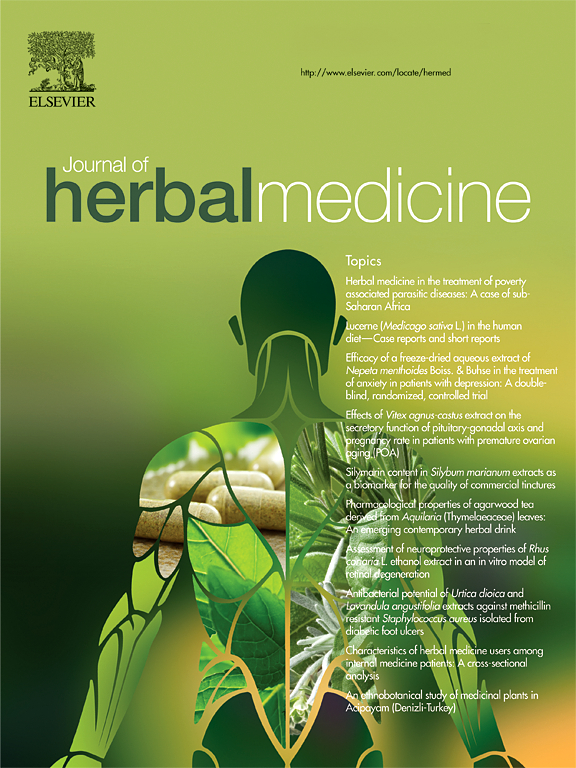Aloe ferox, Agathosma betulina, and Bulbine frutescens Extracts Show Antifungal Activity at Concentrations Favourable to the Proliferation of Epidermal Cells
IF 1.9
4区 医学
Q2 INTEGRATIVE & COMPLEMENTARY MEDICINE
引用次数: 0
Abstract
Introduction
The increasing prevalence of antifungal resistance presents an enormous challenge to healthcare professionals. The adverse effects and resistance of current antifungal drugs have prompted the need for alternate antifungal therapy in the form of natural products. Although anecdotal reports have suggested that Aloe ferox, Agathosma betulina, and Bulbine frutescens have been used to successfully treat fungal skin infections, little scientific evidence is available to validate these claims. Therefore, this study aimed to determine whether the concentrations of A ferox, A betulina, and B frutescens hydroethanolic extracts showing antifungal activity against skin-related Candida species are cytotoxic to normal human epidermal cells.
Methods
Crystal violet and lactate dehydrogenase assays were employed to determine cell viability and cytotoxicity on the human epidermal cells. Broth microdilutions were performed to evaluate the susceptibility of Candida species to plant extracts.
Results
Candida spp. inhibition was observed at a concentration of 200 µg/ml, while optimum extract concentrations for cell proliferation ranged between 200 and 400 µg/ml for B frutescens and 200 µg/ml for A ferox and A betulina. This suggests that these plants could prove to be effective as antifungal agents at a dosage of 200 µg/ml while still supporting the growth of epidermal cells at the same concentration, which is an important process in maintaining healthy skin.
Conclusions
These findings from this study lay a foundation for further studies confirming the applicability of these medicinal plants as safe alternative antifungal treatments that promote skin cell proliferation, regeneration, and enhance tissue repair.
芦荟、白桦松茸和球根草提取物在有利于表皮细胞增殖的浓度下显示出抗真菌活性
越来越普遍的抗真菌药物耐药性给医护人员带来了巨大的挑战。目前抗真菌药物的不良反应和耐药性促使人们需要以天然产物的形式替代抗真菌治疗。尽管坊间报道表明,芦荟、白桦木条和球果已被用于成功治疗真菌皮肤感染,但几乎没有科学证据可以证实这些说法。因此,本研究旨在确定对皮肤相关念珠菌具有抗真菌活性的白桦、白桦和果蔓氢乙醇提取物的浓度是否对正常人表皮细胞具有细胞毒性。方法采用结晶紫法和乳酸脱氢酶法测定人表皮细胞的细胞活力和细胞毒性。采用肉汤微稀释法评价念珠菌对植物提取物的敏感性。结果200 µg/ml对scandida spp有抑制作用,而对B frutescens、a ferox和a betulina细胞增殖的最佳提取浓度为200 ~ 400 µg/ml。这表明,在200 µg/ml的剂量下,这些植物可以被证明是有效的抗真菌剂,同时在相同的浓度下仍然支持表皮细胞的生长,这是维持皮肤健康的重要过程。结论本研究结果为进一步研究证实这些药用植物作为促进皮肤细胞增殖、再生和组织修复的安全替代抗真菌药物的适用性奠定了基础。
本文章由计算机程序翻译,如有差异,请以英文原文为准。
求助全文
约1分钟内获得全文
求助全文
来源期刊

Journal of Herbal Medicine
INTEGRATIVE & COMPLEMENTARY MEDICINE-
CiteScore
3.90
自引率
0.00%
发文量
94
期刊介绍:
The Journal of Herbal Medicine, the official journal of the National Institute of Medical Herbalists, is a peer reviewed journal which aims to serve its readers as an authoritative resource on the profession and practice of herbal medicine. The content areas of the journal reflect the interests of Medical Herbalists and other health professionals interested in the clinical and professional application of botanical medicines. The objective is to strengthen the research and educational base of herbal medicine with research papers in the form of case studies, original research articles and reviews, monographs, clinical trials and relevant in vitro studies. It also publishes policy statements, opinion pieces, book reviews, conference proceedings and profession related information such as pharmacovigilance reports providing an information source for not only the Herbal Practitioner but any Health professional with an interest in phytotherapy.
 求助内容:
求助内容: 应助结果提醒方式:
应助结果提醒方式:


